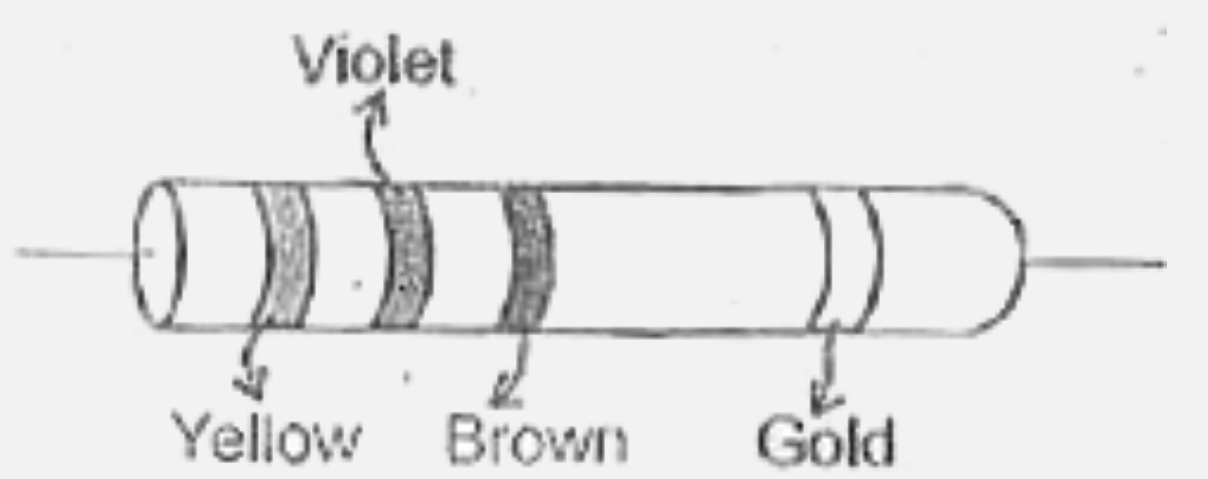The four colours on a resistor are: brown, yellow, green and gold as read from left to right. What is resistance corresponding to these colours.
To determine the resistance of a resistor based on its color code, we will follow these steps:
Step 1: Identify the Colors
The colors on the resistor are:
- Brown
- Yellow
- Green
- Gold
Step 2: Assign Numerical Values to the Colors
Using the standard resistor color code, we assign the following values:
- Brown = 1
- Yellow = 4
- Green = 5
- Gold = Tolerance (5%)
Step 3: Formulate the Resistance Value
The first two colors (Brown and Yellow) represent the significant digits of the resistance. Therefore:
- First digit (Brown) = 1
- Second digit (Yellow) = 4
So, the significant digits are 14.
Step 4: Determine the Multiplier
The third color (Green) indicates the multiplier:
- Green = 10^5
Step 5: Calculate the Resistance
Now, we combine the significant digits with the multiplier:
Resistance=14×105Ω
This can be expressed as:
Resistance=1.4×106Ω
Step 6: Determine the Tolerance
The fourth color (Gold) indicates the tolerance:
- Gold = ±5%
Final Answer
Thus, the resistance of the resistor is:
1.4×106Ωwith a tolerance of±5%
---
The colors on the resistor are:
- Brown
- Yellow
- Green
- Gold
Using the standard resistor color code, we assign the following values:
- Brown = 1
- Yellow = 4
- Green = 5
- Gold = Tolerance (5%)
The first two colors (Brown and Yellow) represent the significant digits of the resistance. Therefore:
- First digit (Brown) = 1
- Second digit (Yellow) = 4
The third color (Green) indicates the multiplier:
- Green = 10^5
Now, we combine the significant digits with the multiplier:
Resistance=14×105Ω
This can be expressed as:
Resistance=1.4×106Ω
The fourth color (Gold) indicates the tolerance:
- Gold = ±5%
Thus, the resistance of the resistor is:
1.4×106Ωwith a tolerance of±5%
Topper's Solved these Questions
- CURRENT ELECTRICITYBOOK - DC PANDEYCHAPTER - CURRENT ELECTRICITYEXERCISE - Example Type 1
2 Videos
- CURRENT ELECTRICITYBOOK - DC PANDEYCHAPTER - CURRENT ELECTRICITYEXERCISE - Example Type 2
1 Videos
- COMMUNICATION SYSTEMBOOK - DC PANDEYCHAPTER - COMMUNICATION SYSTEMEXERCISE - Subjective
11 Videos
- ELECTROMAGNETIC INDUCTIONBOOK - DC PANDEYCHAPTER - ELECTROMAGNETIC INDUCTIONEXERCISE - Medical entrances gallery
25 Videos
Similar Questions
Knowledge Check
The colour sequence in a carbon resistor is red, brown, orange and silver. The resistance of the resistor is
A21×105Ω±10%B23×101Ω±10%C21×103Ω±5%D12×107Ω±5%The colour sequence in a carbon resistor is red, brown, orange and silver. The resistance of the resistor is
A21×103±10%B23×101±10C21×103±5%D12×103±5%A carbon resistor has colour strips as violet, yellow brown and golden. The resistance is
A641ΩB741ΩC704ΩD407Ω
A current of 2 mA is passed through a colour coded carbon resistor with first, second and third rings of yellow, green and orange colours. What is the voltage drop across the resistor?
View SolutionA current of 2 mA is passed through a colour coded carbon resistor with first, second and third rings of yellow, green and orange colours. What is the voltage drop across the resistor ?
View SolutionA carbon resistor has coloured strips as shown is figure. What is its resistance ?

View SolutionGreen colour of bile is derived from
View SolutionA carbon film resistor has colour green, black, violet and gold . The value of the resistor is
View Solution
